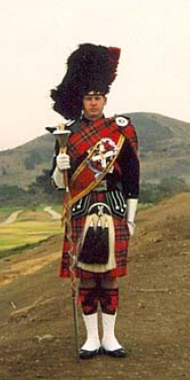| This Week’s Topic… | |||

Best viewed in
|
The Drum Major
The Regimental Drum Major Association http://drummajor.net is one of a number of organizations preserving the heritage, history, and pageantry of drum majoring. http://www.youtube.com/watch?v=VuW8095nIhU
The mace has long been associated as a symbol of authority. The drum major uses the mace to convey signals to the pipes and drums. Mace commands vary from regiment to regiment and historically have been handed down from drum major to drum major. Generally, starts, stops, and counter march commands are similar amongst the regiments since these commands are those commonly used with massed bands and tattoos. The mace derives from the medieval weapon of the same name. It was composed of a spiked head attached by a chain to a wooden handle. The mace was swung around the head to clear a path or to strike an unhorsed opponent. The basic parts remain, although adapted. The body or shaft of the mace may consist of Malacca cane, wood, or fiberglass. The shaft may be wrapped in either chain, cord, or be left plain. The proper length of the mace is shoulder height from ferrule to finial. There are a number of competitions for Drum Majors including Field Inspection, “L” and “I” Pattern, and Field Conducting. Field Inspection is a judging of the Drum Major’s dress and deportment. Field Conducting includes parade, festivals, field shows, and conducting with or without a band. “I” Pattern consists of a step-off, salute, and halt in an area approximately 150’ in length with Salute line in the middle. Here is a video clip example: “L” Pattern consists of a retraced “L” measuring 150’ by 70’. Competitors must execute the following commands in the given order: 1. 2-3 Vocal Commands 5. Right Turn 2. Forward March 6. Salute 3. Left Turn 7. Mark Time 4. Counter March 8. Halt/Dismissal Competitors must execute some kind of Beating of Time following each command. Time limit is four (4) minutes. Timing begins on the first count after the execution whistle or vocal for Step Off and ends after the dismissal of the band. Here is a sample clip: http://www.youtube.com/watch?v=VN2UPjws-KA Here’s one of the finest examples of mace spinning I’ve seen. Watch the timing of the mace work and the music: http://www.youtube.com/watch?v=73xsZ06Xezs |
||

